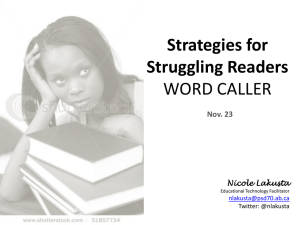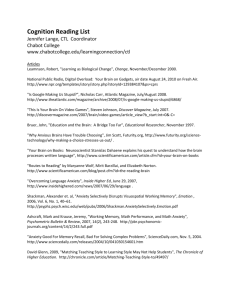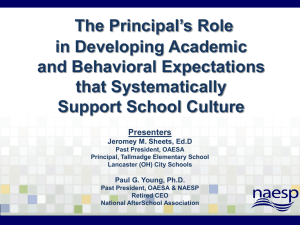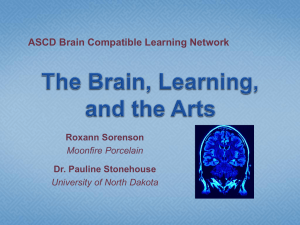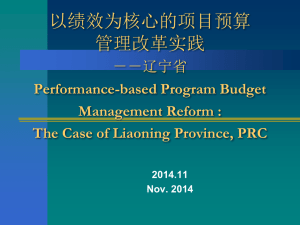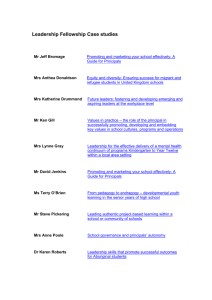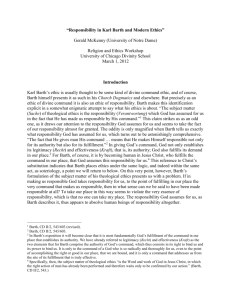LEADERSHIP BIBLIOGRAPHY
advertisement
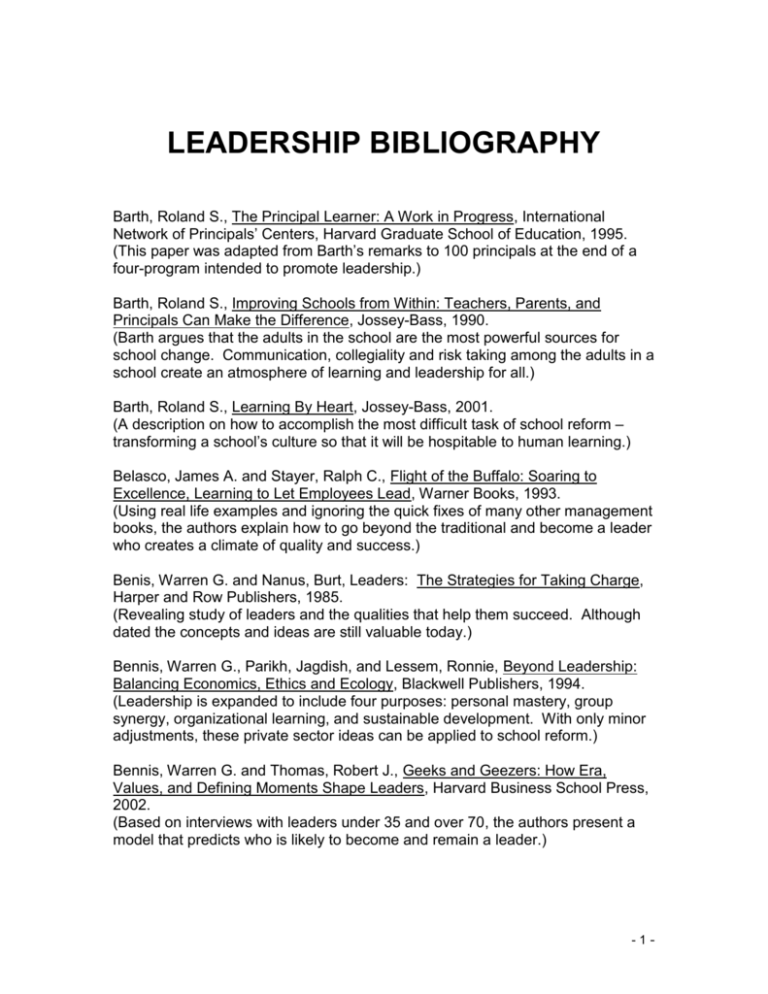
LEADERSHIP BIBLIOGRAPHY Barth, Roland S., The Principal Learner: A Work in Progress, International Network of Principals’ Centers, Harvard Graduate School of Education, 1995. (This paper was adapted from Barth’s remarks to 100 principals at the end of a four-program intended to promote leadership.) Barth, Roland S., Improving Schools from Within: Teachers, Parents, and Principals Can Make the Difference, Jossey-Bass, 1990. (Barth argues that the adults in the school are the most powerful sources for school change. Communication, collegiality and risk taking among the adults in a school create an atmosphere of learning and leadership for all.) Barth, Roland S., Learning By Heart, Jossey-Bass, 2001. (A description on how to accomplish the most difficult task of school reform – transforming a school’s culture so that it will be hospitable to human learning.) Belasco, James A. and Stayer, Ralph C., Flight of the Buffalo: Soaring to Excellence, Learning to Let Employees Lead, Warner Books, 1993. (Using real life examples and ignoring the quick fixes of many other management books, the authors explain how to go beyond the traditional and become a leader who creates a climate of quality and success.) Benis, Warren G. and Nanus, Burt, Leaders: The Strategies for Taking Charge, Harper and Row Publishers, 1985. (Revealing study of leaders and the qualities that help them succeed. Although dated the concepts and ideas are still valuable today.) Bennis, Warren G., Parikh, Jagdish, and Lessem, Ronnie, Beyond Leadership: Balancing Economics, Ethics and Ecology, Blackwell Publishers, 1994. (Leadership is expanded to include four purposes: personal mastery, group synergy, organizational learning, and sustainable development. With only minor adjustments, these private sector ideas can be applied to school reform.) Bennis, Warren G. and Thomas, Robert J., Geeks and Geezers: How Era, Values, and Defining Moments Shape Leaders, Harvard Business School Press, 2002. (Based on interviews with leaders under 35 and over 70, the authors present a model that predicts who is likely to become and remain a leader.) -1- Blasé, Joseph and Kirby, Peggy C., Bringing Out the Best in Teachers: What Effective Principals Do. Corwin Press, 1992. (A valuable resource outlining various factors principals can use to influence and motivate teachers and students. Each chapter concludes with a set of recommendations.) Block, Peter, Stewardship: Choosing Service Over Self-Interest, Berrett-Koehler Publishers, Inc., 1993. (By choosing service over self-interest organizations offer employees, choice at all levels. Valued employees are more likely to select responsibility over entitlement and hold themselves accountable.) Bossidy, Larry and Charan, Ram, Execution: The Discipline of Getting Things Done, Crown Business, 2002. (Practical insights and advice on managing for results. The book defines execution and how it brings together the people, strategies, and operations of the organizations.) Bogue, E. Grady, The Enemies of Leadership: Lessons for Leaders in Education, Phi Delta Kappa Educational Foundation, 1985. (From Apathy to Rigidity, Bogue uses ten chapters to describe how common behaviors can be misused and become “enemies of leadership’.) Bolman, Lee G. and Deal, Terrence E., Leading With Soul, Jossey Bass, 2001. Bonstingl, John Jay, Schools of Quality: An introduction to Total Quality Management in Education, ASCD, 1992. (A nice introduction to Deming’s 14 points and how to apply them to education.) Bridges, William, Managing Transitions, Making the Most of Change, Addison-Wesley Publishing Group, 1991. (A description of the stages of change and how leaders can use their enhanced understanding to manage change in their groups and lead their constituents through it to a future they help shape.) Burns, James MacGregor, Leadership, Harper Torchbooks, Harper & Row, 1978. (A seminal work on leadership. The philosophic analysis of the past and foundation for present and future leadership.) Burns, Hames MacGregor, Transforming Leadership: A New Pursuit of Happiness, Atlantic Monthly Press, 2002. (Using vignettes from U.S. and world history and reading them in light of new sociological and psychological research, Burns aims to put “transforming leadership” at the core of Western values. Byham, William C. Ph.D., Zapp! In Education, Ballantine Books, 1992 (A fable to lead educators through the empowerment process. First teachers are empowered and then they pass this on to their students and exciting things start to happen.) -2- Byham, William C. Ph.D. with Jeff Cox, Zapp! The Lightning of Empowerment, Harmony Books, 1988. (Story outlining the basic principles of empowering people, about helping employees take ownership of their jobs so that they take personal interest in improving the performance of the organization.) Carr, Judy F. and Harris, Douglas E., Succeeding with Standards: Linking Curriculum, Assessment, and Action Planning, ASCD, 2001. (Useable blueprint for incorporating a standards-linking process.) Carter, Samuel Casey, No Excuses, Lessons from 21 High Performing, High Priority Schools, The Heritage Foundation, 2001. Comer, James P., School Power: Implications of an Intervention Project, Free Press, 1980. (Dr. Corner’s first book, through the lens of experience we can see how the School Development Program evolved. The struggles of this early reform effort can reinforce the urgency of our efforts today.) Comer, James P. M.D., Waiting for a Miracle: Why Schools Can’t Solve Our ProblemsAnd How We Can, Dutton, 1997. (Dr. Comer’s understanding of child development and experience with school reform enable him to lay out some conditions for effective school improvement program. A program that can make the miracle of educational reform happen for our students.) Comer, James P., Ben-Avie, Michael, Haynes, Norris M., and Joyner, Edward T., Rallying the Whole Village: The Corner Process for Reforming Education, Teachers College Press, 1996. (An outline of Comer’s efforts to translate theory into practice. The power of relationship building in school reform is described and results from some of the SDP schools are shared.) Comer, James P., Ben-Avie, Michael, Haynes, Norris M., and Joyner, Edward T., Child by Child: The Corner Process for Change in Education, Teachers College Press, 1999. (Description of the efforts to implement the Yale School Development Program (SDP) across the nation. Powerful stories of the day-to-day experiences of change in school communities.) Conley, David T., Are You Ready to Restructure? A Guidebook for Educators, Parents, and Community Members, Corwin Press, 1996. (Conley discuss all aspects of restructuring from the rationale through difficulties of change to some ideas on how to go about restructuring.) Cooper, Robert K., Ph.D. and Sawaf, Ayman, Executive EQ: Emotional Intelligence in Leadership & Organizations, Grosset/Putnam, 1997. (The work of Goleman is extended to the workplace. Sixteen competencies are detailed and an “EQ Map” is presented to measure the reader’s emotional quotient.) -3- Covey, Stephen R., The 7 Habits of Highly Effective People: Restoring the Character Ethic, Fireside Book by Simon & Schuster, 1990.An outline for “principal centered” change in self and/or within an organization.) Covey, Stephen R., Principle Centered Leadership, Simon and Schuster, 1992. (Covey describes his recipe for individual survival during tremendous change. He believes that we must recognize both our own and our colleagues’ principle centered core. This recognition leads to personal and organization growth and success.) Covey, Stephen R., Merrill, A. Roger, and Merrill, Rebecca R., First Things First, Fireside Book by Simon and Schuster, 1995. (A plan to develop and maintain a sense of self while working for systemic change. Protection of personal priorities leads to more energy and focus on obtaining the organization’s vision.) Crowther, Frank, Kaagan, Stephen S., Ferguson, Margaret, Hann, Leonne, Developing Teacher Leaders: How Teacher Leadership Enhances School Success, Corwin Press, 2002. (The authors approach the looming vacuum in school leadership from a uniquely proactive perspective. They have not only outlined a solid framework for thinking about parallel leadership, but have created a variety of experiential learning activities to use as a process for developing shared meaning and energy within the learning community.) Danielson, Charlotte, Enhancing Student Achievement: A Framework for School Improvement, ASCD, 2002. (If we truly committed to improving our schools we must focus on the interdependence of variables that affect student learning. Part 1 defines the criteria for successful school improvement, Part 2 provides a framework for school improvement and Part 3 offers guidelines on how to implement the framework using action planning.) Danielson, Charlotte, and McGreal, Thomas L., Teacher Evaluation: To Enhance Professional Practice, ASCD, 2000. (Using concrete examples, useful forms, and assessment tools, this book provides a clear roadmap to effective teacher evaluation systems.) Deal, Terrence E. and Peterson, Kent D., The Leadership Paradox: Balancing Logic and Artistry in Schools, Jossey-Bass, 1994. (Collection of reality-based cases and concepts worthy of reflection by all interested in school leadership.) Deal, Terrence E. and Peterson, Kent D., Shaping School Culture: The Heart of Leadership, San Francisco, CA: Josey-Bass, Inc. 1991. Duren, Dr. Paula, Signs of Change, Duren and Associates, Inc., 1997. (A short pamphlet, 28 pages, summarizing current thoughts on managing change.) Fullan, Michael & Hargreaves, Andy, What’s Worth Fighting For? Working Together For Your School, Toronto, Ontario, Canada: The Regional Laboratory for Educational Improvement of the Northeast Islands with the Ontario Public School Teacher’s Federation, 1991. -4- Garmston, Robert J. and Wellman, Bruce M., The Adaptive School: A Sourcebook for Developing Collaborative Groups, Christopher-Gordon Publishers, Inc., 1999. (This book is a practical guide for anyone who believes that schools can be made better and who is accepting the challenge of implementing systematic change.) Garmston, Robert J. and Wellman, Bruce M., The Adaptive School: Developing and Facilitating Collaborative Groups, Garmston and Wellman Four Hats Seminars, 2000. (A collection of resources and strategies to use while working towards systemic organizational change.) Glasser, William M.D., Choice Theory: A New Psychology of Personal Freedom, HarperCollins, 1998. (From the author of Reality Therapy an effective way to get to know people. Choice Theory is a non-controlling psychology that gives us the freedom to sustain the relationships that lead to productive lives.) Glasser, William M.D., The Quality School: Managing Students without Coercion, HarperCollins, 1992. (Glasser’s interpretation of “control theory” as applied to Deming’s teachings and school reform.) Goleman, Daniel, Emotional Intelligence, Bantam, 1997. (This groundbreaking book introduced many of us to the influence emotions have on an individual’s success. Goleman draws on brain and behavior research to show why many highly talented men and women fail to reach the success predicted for them.) Green, Robert L., PhD., How Teacher Expectations Can Increase Student Achievement, Dillon, Colorado: Alpine Guild, Inc. 2000. Gupton, Sandra Lee, The Instructional Leadership Toolbox: A Handbook for Improving Practice, Corwin Press, 2003. (Carrying the analogy of a toolbox throughout the book Dr. Gupton presents her perspectives on the role of an instructional leader and provides “tools” drawn from research for principals to use as they examine their schools and reform efforts.) Johnson, Spencer, M.D., Who Moved My Cheese? G.P. Putnam’s Sons, 2002. (A simple, short story that has become an instant classic. Cheese is what we want out of life and the characters deal with change in a variety of ways allowing readers to better understand how to cope with change in their lives.) Kaser, Joyce, Mundry, Susan, Stiles, Katherine E., Louhs-Horsley, Susan, Leading Everyday, Wested, 2002. Kessler, Rachael, The Soul of Education: Helping Students Find Connection, Compassion, and Character at School, ASCD, 2000. (A collection of moving stories of students and their yearnings. The book describes methods for helping students find ways to express their longings, increase their motivation and strengthen family, friends and community.) -5- Kotter, John P., Leading Change, Harvard Business School Press, 1996.(Puts the change process in the larger context of social and economic forces. Examples of the eight mistakes of managing change as well as the eight-step change process.) Lambert, Linda, Leadership Capacity for Lasting School Improvement, ASCD, 2003. (Looks at shared leadership within the framework of school improvement.) Lambert, Linda, Building Leadership Capacity in Schools, ASCD, 1998. (The author takes a look at shared school leadership. She defines leadership as the learning process that lead toward a shared sense of purpose.) Maltz, Maxwell, M.D., F.I.C.S., Psycho-Cybernetics, Pocket Books, 1960. (The value of self-image; how you can discover and develop your own and understand the part it plays in each of our lives.) Matthews, David, Is There a Public for Public Education?, Kettering Foundation Press, 1996. (It will not be enough to improve the schools, the relationship between the schools and the community must be repaired.) McEwan, Elaine K., 10 Traits of Highly Effective Principals, Corwin Press, 2003. (Dr. McEwan describes the traits that lead to being an effective school leader.) McEwan, Elaine K., 7 Steps to Effective Instructional Leadership, 2nd Edition, Corwin Press, 2003. (Practical guide to improving school effectiveness. McEwan blends educational theory with practice.) Meier, Deborah, The Power of Their Ideas: Lessons for America from a Small School in Harlem, Beacon Press, 1995. (The description of changes and advancements made at Central Park East in East Harlem. Meier shares her commitment to public education and her philosophy for change developed during her years as a teacher and principal.) Monroe, Lorraine, Nothing’s Impossible: Leadership Lessons from Inside and Outside the Classroom, Public Affairs, 1999. (A plain spoken description complete with challenges, setbacks and doubts of Dr. Monroe’s passionate campaign to turn around one Harlem school and the lessons her experiences have for all of us.) Pritchett, Price, Resistance: Moving Beyond the Barriers to Change, USA: Pritchett & Associates, Inc. 1996. Robins, Pam & Alvy, Harvey B., The Principal’s Companion: Strategies and Hints to Make the Job Easier, Thousand Oaks, CA: Corwin Press Inc., 1995. (An easy to read book of tips to help principals move through the day.) Savary, Louis M., Ph.D., Creating Quality Schools, American Association of School Administrators, 1995. (A 32- page pamphlet explaining Total Quality Management and continuous improvement. A nice, easy first read on TQM.) -6- Schein, Edgar H., Process Consultation, Volume I Its Role in Organization Development, 2nd Edition, Addison & Wesley Organization Development Series, 1988. (outlines the basic concepts and techniques of process consultation for both students and practitioners. Will enable managers to become more effective and enable them to influence situations without direct use of power.) Schein, Edgar H., The Corporate Culture Survival Guide, A Warren Bennis Book, Jossey-Bass, Inc., 1999. (A collection of answers about organizational culture, what it is, how to change it, and how if influences the way workers complete their tasks.) Schlechty, Phillip C., Inventing Better Schools: An Action Plan for Educational Reform, Jossey-Bass, 1996. (A realistic appraisal of the critical need for public schools to use research in accepting the challenge to reform. You might paraphrase Schlechty’s warning as “Reform or Perish”. The book gives excellent background information and some very useful “how-tos”.) Schmoker, Mike, Results: The Key to Continuous School Improvement, 2nd Edition, ASCD, 1999. (The single most complete description of how to use data to guide school improvement. Schmoker emphasizes the need to identify short term “signposts” to monitor our progress to long-term reform.) Schwahn, Charles J. and Spady, William G., Total Leaders: Applying the Best FutureFocused Change Strategies to Education, AASA, 1998. (An attempt to put the minds and insights of the most respected authorities to work in one simple yet dynamic leadership and change model that will strengthen leadership insights, performance, and effectiveness.) Senge, P.M., The Fifth Discipline, The Art and Practice of the Learning Organizations, Doubleday, 1990. (Schools and other organizations must become “learning organizations” that discover how to promote learning if they are to survive.) Senge, P.M., Kleiner, A., Roberts, C., Ross, R., and Smith, B.J., The Fifth Discipline: Strategies and Tools for Building a Learning Organization, Currency and Doubleday, 1994. (A companion “toolkit” for the Fifth Discipline. A reference to use versus a book to read.) Sergiovanni, Thomas J., Building Community in Schools, Jossey-Bass Publishers, 1994. (Goes beyond the usual advocacy of community to a thorough development of why schools should build community and some good insights on how to go about it.) Sergiovanni, Thomas J., Moral Leadership: Getting to the Heart of School Improvement, Jossey-Bass, 1992. (Using purpose, values and beliefs, Sergiovanni shows how a new leadership style can lead a school from an organization to a community.) -7- Sergiovanni, Thomas J., Supervision Human Perspectives, McGraw-Hill Book Company, 1983. (Textbook approach to the many dimensions of supervision. The emphasis is on human resource supervision as a staff development activity geared to a formative approach.) Shedd, Joseph B. and Bacharach, Samuel B., Tangled Hierarchies: Teachers as Professionals and the Management of Schools, Jossey-Bass, 1991. (The authors draw form research in private sector management to point out that many of the initiatives aimed at reforming and improving schools may be contraindicated. The formal demands and reinforcement of role restrictions may limit the very flexibility, risk taking and cooperation necessary to achieve true reform.) Smith, Wilma F. and Andrews, Richard L., Instructional Leadership: How Principals Make a Difference, ASCD, 1989. (Surveying over 1200 school principals that authors arrived at expectations and descriptors for a clinical supervision model for principals and suggestions for making good principals even better.) Swenson, Richard A. M.D., Margin: Restoring Emotional, Physical, Financial, and Time Reserves to Overloaded Lives, Navpress, 1992. (The great demands on school leaders can lead to “burn-out” and inefficiency. To be at their best leaders must take care of their selves. This plan helps maintain balance in one’s life.) Wahlstrom, Deborah, Using Data to Improve Student Achievement: A Handbook for Collecting, Organizing, Analyzing and Using Data, Successline Publicatoins, 1999. (If you can only own one book on data, this is the book. A clear, simple approach to collecting, organizing, and using data.) Weber, Larry, The Provocateur: How a Generation of Leaders are Building Communities Not Just Companies, Crown Business, 2001. (Provocateurs are the new generation of leaders who promote the group, encourage individuality and put their customers at the center of everything. This interesting collection of case studies shows how modern leaders have been created communities in their organizations.) Wortman, Robert, Administrators: Supporting School Change. The Galef Institute, 1995. (A short booklet that could be used to promote a discussion and reflection on the principal’s role and life.) This bibliography was created by the Partnership for Success Program, Michigan Department of Education, with additions from the EPFP Learning Team. -8-
